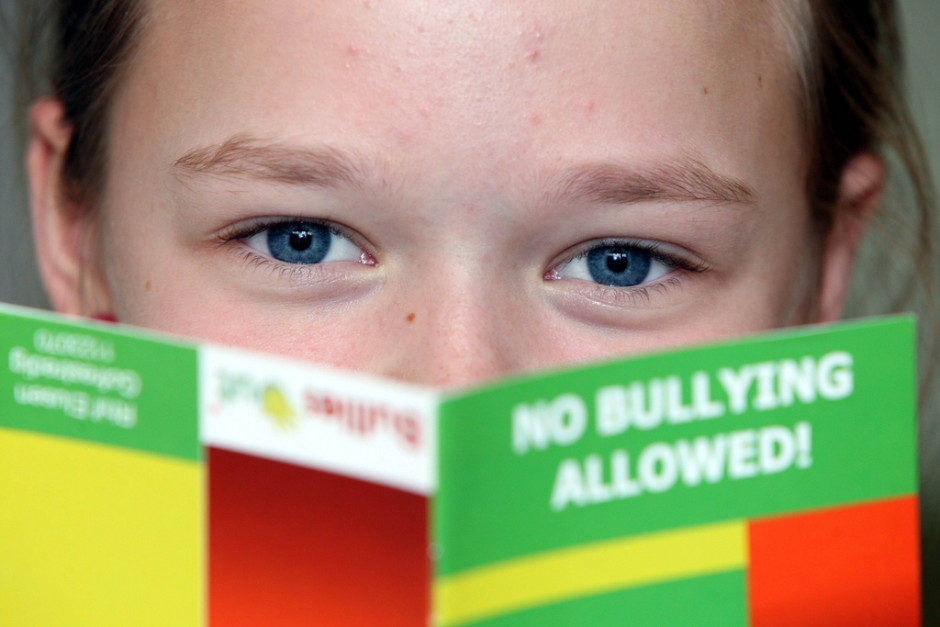by Cynthia Roebuck
Bullying happens everywhere in classrooms and playgrounds in our youth’s lives, but also it is happening on our college campuses and even workplaces and our personal adult lives. Bullying has gained lots of recognition in the media with schools implementing anti-bulling programs. But most of these programs seem to attack the already developed behavior whereas addressing why the behavior was allowed to develop into a problem for society has less attention. In letters shared between Einstein and Freud, Freud argued that aggression was natural (Einstein & Freud, 1932), but behavior can be modified through social learning principles. Bandura posits that situational, cognitive, and reinforcement controls should be targeted instead of focusing on traits or historical reasons and brings to the topic Ackerman’s beliefs that the child acts out not because they are not loved, but because they cannot trust (Bandura, 1973, p. 245).
This points to the importance of the moral climate in a classroom, because this is where youth develop an understanding of what the social norms are for aggression, and it is an area in much need of research when considering the commonality across the world of school violence occurring (Alexitch, 2012, p.210). Because most emerging adults socialize primarily in an electronic environment via text, chat, social media, and video games, they are faced with forms of indirect aggression in the form of social bullying called cyberbullying. This form of bullying involves directly telling a person they are not wanted, excluding them from group activities, ignoring, spreading rumors, keeping other friends away, and creating situations where the person will be embarrassed. This is understood to be a form of psychological violence carried out to inflict psychological harm onto another (StuartCassel, Terzain, and Bradshaw, 2013; Taki, Slee, Hymel, Pepler, Sim & Swearer, 2008).
Taki et al. did a longitudinal comparative study to determine the long-term effects of indirect aggression in Australia, Canada, China, Japan, Korea, and the United States (2008). They found there to be long lasting psychological harm caused from indirect aggression, but because the scars were not visible proper attention to the seriousness of this behavior are not considered thoroughly enough ( p. 4). They identify three forms — “membership, power of exchangeable status, and frequency of victimization” (p. 6), and it occurs in several scenarios — taking something away, teasing, ignoring, and exclusion (p. 7). Interestingly enough, collectivist societies have given this type of bullying its own name — Japan: ijime and Korea: wang-ta. Is cyberbullying a version of this in America?
Interventions to prevent bullying behavior from developing should be set in place at grade schools to encourage a collaboration amongst students in order to break down the social barriers by modifying aggressive behaviors in individuals through showing alternative ways to work together. This is why the jigsaw classrooms have been invited into places like Columbine in Colorado to try to counteract the negative effects of cliques (Gilbert, 2001). Aronson was invited to Columbine to advise on a collaborative learning environment called the jigsaw classroom that restructures the classroom environment into smaller groups with students engaging with each other to collectively accomplish the requirements of the lesson instead of competing to be better than one another (McNulty, 2004). The jigsaw classrooms have shown to change the attitudes of students and lead to behavioral change as stereotypes are discarded as classmates begin to see more than the one dimensional stereotype through interaction with one another (APA, 2015). This approach to learning has also been found to be successful in undergraduate studies (Lom, 2012).
Together we can better identify and make known what bullying is, so we can remove any ambiguity surrounding recognizing direct and indirect aggressive bullying behavior. If we do, then, the bystander effect where someone may not help will be reduced, because recognizing that a person is being bullied will easily be seen for what it is. In the meantime, take a moment each day to do one random act of kindness through engaging with your environment. Set an example that it is okay to care, and speak up…
References
Alexitch, L.R. (2012). Applying Social Psychology to Education in Applied Social Psychology: Understanding and Addressing Social and Practical Problems (2nd ed.) F.W. Schnedier, J.A. Gruman, & L.M. Coutts (Eds.). Thousand Oaks, CA: Sage Publications. ISBN 978-1412976381.
APA. (2015). How to Build a Better Educational System: Jigsaw Classrooms. American Psychological Association. Retrieved 30 January 2015 from http://www.apa.org/research/action/jigsaw.aspx.
Bandura, A. (1973). Aggression. Prentice-Hall. ISBN: 0-13-020743-8.
Einstein, A & Freud, S (1932). Why war? Einstein’s letter to Freud and Freud’s Response. Sequoia Free Press reprint 2010. ASIN: B003NZ932K.
Gilbert, S. (2001). A CONVERSATION WITH/Elliot Aronson; No One Left to Hate: Averting Columbines. New York Times. Retrieved 23 March 2015 from http://www.njbullying.org/Aronsoninterview.txt.
Lom, B. (2012). Classroom Activities: Simple Strategies to Incorporate Student-Centered Activities within Undergraduate Science Lectures. Journal of Undergraduate Neuroscience Education, 11(1), A64–A71.
Maryland GovPics. (2014). It’s Cool to be Nice. First Lady Katie O’Malley Attends a National Anti Bullying Event at Mother Seton Academy. Retrieved from https://www.flickr.com/photos/mdgovpics/15356566737/in/photolist-pFd5sr-pDmkbA-oJAgRh-oJAghw-pp1qh2-oJAfcq-poZH4S-pFd1t4-pp1odT-pp3ixj-pFw1ML-pp3hv9-pp3gTY-pFrGfX-q7s3Rr-duXQEq-oJDgN4-a3wTiC-dpdReD-dpe1kJ-dpdQRp-dpdZPd-dpdQmr-dpdZus-dpdQ1B-dpdPPP-dpdZ1S-dpdPwi-dpdPo6-dpdPbT-dpdNXZ-dpdNNM-dpdNDv-dpdXQA-dpdXDw-dpdXrC-dpdMT4-dpdMJV-dpdWTJ-dpdMkp-dpdMan-dpdWhW-dpdW4W-dpdVV9-dpdLfk-dpdKW8-dpdV51-dpdUVE-dpdUL7-dpdUsW.
McNulty, J. (2004). Preventing Columbine: Psychologist Elliot Aronson delivers Faculty Emeritus Lecture February 11. UC Santa Cruz Currents Online. Retrieved from http://currents.ucsc.edu/03-04/02-02/aronson.html.
Stuart-Cassel, V, Terzain, M, & Bradshaw, C. (2013). SOCIAL BULLYING: Correlates, Consequences, and Prevention. Safe Supportive Learning. Retrieved 18 Feb 2015 from http://safesupportivelearning.ed.gov/sites/default/files/1315%20NCSSLE%20Social%20Bullying%20d7_lvr_0.pdf.
Taki, M., Slee, P., Hymel, S., Sim, H-O, & Swearer, S. (2008). A New Definition and Scales for Indirect Aggression in Schools. International Journal of Violence and School. Retrieved 2 Feb 2015 from http://www.ijvs.org/files/Revue-07/01.-Taki-Ijvs-7.pdf.
Working Word. (2009). Anti-bullying Respect Tour 2009. Retrieved from https://www.flickr.com/photos/workingword/4663156174/in/photolist-874TSo-5ZZxpm-hSsF8H-hSsE4m-bzbf5r-4ZXvxq-bmgnJW-bmgn1C-bmgiys-bmgV25-bzbMdz-bmgUDA-bmgUpd-bzbLwp-bmgTYj-bzbL7c-bzbKVc-bzbKJ6-bmgT1C-bzbK7X-bzbfR4-bzbfEB-bmgnzU-bzbePH-bzbeoK-bmgmxL-bmgmmy-bzbdBp-bzbdqV-bzbdag-bmgkm5-bmgkbj-bmgjWE-bzbcoH-bmgjBj-bzbbWT-bzbbJt-bmgiXU-bzbbm6-bmgijY-bmgi77-bmghSC-bzbabx-bzb9M4-bmggXj-bmggN5-bmggA3-bmggqW-bzb8KV-bzbKyi.
by Cynthia Roebuck
April 19, 2015

